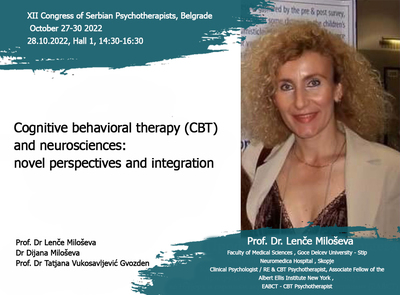Miloseva, Lence and Miloseva, Dijana and Vukosavljevic-Gvozden, Tatjana (2022) Cognitive Behavioral Therapy (CBT) and Neurosciences: Novel perspectives and integration. In: Book of Abstracts, XII Congress of Serbian Psychotherapists, 27-30 Oct 2022, Belgrade.
Program - 12. kongres psihoterapeuta 2022. FINAL (1).pdf - Published Version
Download (113kB)
Miloseva&Vukosavljevic Gvozden BG 2022.pdf - Published Version
Download (355kB)
![Prof.Lence Miloseva BG 2022.jpg [thumbnail of Prof.Lence Miloseva BG 2022.jpg]](https://eprints.ugd.edu.mk/30468/3.hassmallThumbnailVersion/Prof.Lence%20Miloseva%20BG%202022.jpg)

Prof.Lence Miloseva BG 2022.jpg
Download (374kB) | Preview
Kongres psihoteraputa Beograd.pdf
Download (72kB)
Abstract
The goal of this review paper is to bring coherence and integration to the broad field of Cognitive behavioral therapy (CBT) psychotherapy practice based on the constraints of neurosciences. This goal was articulated over 100 years ago but is one that can now be realistically envisioned due to advances in neuroscientific knowledge. In recent years, interdisciplinary research in the field of neurosciences has expanded our knowledge about neurobiological correlates of mental processes and changes occurring in the brain due to therapeutic interventions. Although CBT is an established and efficient treatment for a variety of common mental disorders, a considerable number of patients do not respond to treatment or relapse after successful CBT (Månsson, Lueken &Frick, 2020). Based on the findings and different approaches we will present how neurosciences can offer novel perspectives to better understand: (a) the neurobiological underpinnings of CBT, especially neuroplasticity, (b) cognitive activity contributes to dysfunctional behavior and emotional experience through focusing, selective perception, memory and recall, and characteristic cognitive distortion; on a neurobiological level, there is a relationship between top-down and bottom-up regulation of unpleasant emotional states, (c) how we can enrich CBT with neuroscience-informed techniques (augmentation of CBT), (d) neurosciences and enduring changes (implications for CBT), implications why some patients may respond better to CBT than others, thus paving the way for more personalized and effective treatments.
The goal of our paper is also to delineate the mechanisms involved in optimizing the degree and duration of clinical improvement. By translating psychotherapy interventions into brain-based processes, delineating different memory processes and the mechanisms of change associated with each, and understanding the role of emotion in effecting change in interaction with these memory mechanisms, the potential exists to develop a new taxonomy of clinical interventions based on what problems are being targeted, how long they have been in place, how intractable they are, and whether an important goal is to achieve enduring change (Nadel & Lane, 2020). We will introduce some key topics and describe a selection of findings from CBT-related research using tools from neuroscience, with the hope that this will provide clinicians and clinical researchers with a brief and comprehensible overview of the field.
Key words: CBT; Neurosciences; Neuroimaging; Integration; Personalized therapy
| Item Type: | Conference or Workshop Item (Lecture) |
|---|---|
| Subjects: | Medical and Health Sciences > Clinical medicine |
| Divisions: | Faculty of Medical Science |
| Depositing User: | Lence Miloseva |
| Date Deposited: | 14 Nov 2022 11:11 |
| Last Modified: | 14 Nov 2022 11:11 |
| URI: | https://eprints.ugd.edu.mk/id/eprint/30468 |
